Get the latest Microsoft MCSA 70-762 dumps and 70-762 pdf, pass exam certification
Work hard! It’s not hard to get certified! Share the latest Microsoft MCSA 70-762 exam dump for free. online 70-762 exam practice tests. the latest 70-762 exam questions and answers, and guarantee your skills and exam experience! “Developing SQL Databases” – 70-762 exam! pass4itsure.com expert recommendation! Top pass rate!

Get the latest Microsoft MCSA 70-762 pdf
[PDF] Free Microsoft 70-762 pdf dumps download from Google Drive: https://drive.google.com/open?id=16YGfdkXafi6wi18c0U7NNxmFVa3W_bXB
[PDF] Free Full Microsoft pdf dumps download from Google Drive: https://drive.google.com/open?id=1gdQrKIsiLyDEsZ24FxsyukNPYmpSUDDO
Valid information provided by Microsoft officials
Exam 70-762: Developing SQL Databases – Microsoft: https://www.microsoft.com/en-us/learning/exam-70-762.aspx
This exam is intended for database professionals who build and implement databases across organizations and who ensure high levels of data availability. Their responsibilities include creating database files, data types, and tables; planning, creating, and optimizing indexes; ensuring data integrity; implementing views, stored procedures, and functions; and managing transactions and locks.
pass4itsure 70-762 exam Skills measured
This exam measures your ability to accomplish the technical tasks listed below.
- Design and implement database objects (25–30%)
- Implement programmability objects (20–25%)
- Manage database concurrency (25–30%)
- Optimize database objects and SQL infrastructure (20–25%)
The latest Microsoft MCSA 70-762 exam practice questions test your strength
QUESTION 1
You have the following stored procedure: 
The Numbers table becomes unavailable when you run the stored procedure. The stored procedure obtains an
exclusive lock on the table and does not release the lock.
What are two possible ways to resolve the issue? Each correct answer presents a complete solution.
NOTE: Each correct selection is worth one point.
A. Remove the implicit transaction and the SET ANSI_DEFAULTS ON statement.
B. Set the ANSI_DEFAULT statement to OFF and add a COMMIT TRANSACTION statement after the INSERT
statement.
C. Add a COMMIT TRANSACTION statement after the INSERT statement.
D. Remove the SET ANSI DEFAULTS ON statement.
Correct Answer: B
QUESTION 2
You run the following Transact-SQL following statement:
Customer records may be inserted individually or in bulk from an application.
You observe that the application attempts to insert duplicate records.
You must ensure that duplicate records are not inserted and bulk insert operations continue without notifications.
Which Transact-SQL statement should you run?
A. CREATE UNIQUE NONCLUSTERED INDEX IX_Customer_Code ON Customer (Code) WITH (ONLINE = OFF)
B. CREATE UNIQUE INDEX IX_CUSTOMER_Code O Customer (Code) WITH (IGNORE_DUP_KEY = ON)
C. CREATE UNIQUE INDEX IX Customer Code ON Customer (Code) WITH (IGNORE DUP KEY =OFF)
D. CREATE UNIQUE NONCLUSTERED INDEX IX_Customer_Code ON Customer (Code)
E. CREATE UNIQUE NONCLUSTERED INDEX IX_Customer_Code ON Customer (Code) WITH (ONLINE = ON)
Correct Answer: B
IGNORE_DUP_KEY = { ON | OFF } specifies the error response when an insert operation attempts to insert duplicate
key values into a unique index. The IGNORE_DUP_KEY option applies only to insert operations after the index is
created or rebuilt. The option has no effect when executing CREATE INDEX, ALTER INDEX, or UPDATE. The default is
OFF.
QUESTION 3
Note: This question is part of a series of questions that present the same scenario. Each question in the series contains
a unique solution. Determine whether the solution meets the stated goals.
You have a database that contains a table named Employees. The table stores information about the employees of your
company.
You need to implement the following auditing rules for the Employees table:
-Record any changes that are made to the data in the Employees table.
–
Customize the data recorded by the audit operations.
Solution: You implement a user-defined function on the Employees table.
Does the solution meet the goal?
A.
Yes
B.
No
Correct Answer: A
SQL Server 2016 provides two features that track changes to data in a database: change data capture and change
tracking. These features enable applications to determine the DML changes (insert, update, and delete operations) that
were
made to user tables in a database.
Change data is made available to change data capture consumers through table-valued functions (TVFs).
References: https://msdn.microsoft.com/en-us/library/cc645858.aspx
QUESTION 4
Note: This question is part of a series of questions that present the same scenario. Each question in this series contains
a unique solution. Determine whether the solution meets the stated goals.
Your company has employees in different regions around the world.
You need to create a database table that stores the following employee attendance information:
– Employee ID
– date and time employee checked in to work
– date and time employee checked out of work
Date and time information must be time zone aware and must not store fractional seconds.
Solution: You run the following Transact-SQL statement:
Does the solution meet the goal?
A. Yes
B. No
Correct Answer: B
datetime2 defines adate that is combined with a time of day that is based on 24-hour clock. datetime2 can be
considered as an extension of the existing datetime type that has a larger date range, a larger default fractional
precision, andoptional user-specified precision.
References: https://msdn.microsoft.com/en-us/library/bb677335.aspx
QUESTION 5
Note: This question is part of a series of questions that use the same or similar answer choices. An answer choice may
be correct for more than one question in the series. Each question is independent of the other questions in this series.
Information and details provided in a question apply only to that question.
You have a database named DB1. There is no memory-optimized filegroup in the database.
You have a table and a stored procedure that were created by running the following Transact-SQL statements: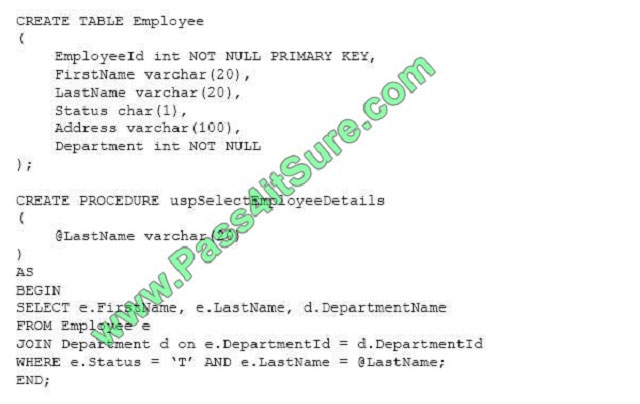
The Employee table is persisted on disk. You add 2,000 records to the Employee table. You need to create an index
that meets the following requirements:
-Optimizes the performance of the stored procedure.
-Covers all the columns required from the Employee table.
-Uses FirstName and LastName as included columns.
–
Minimizes index storage size and index key size. What should you do?
A.
Create a clustered index on the table.
B.
Create a nonclustered index on the table.
C.
Create a nonclustered filtered index on the table.
D.
Create a clustered columnstore index on the table.
E.
Create a nonclustered columnstore index on the table.
F.
Create a hash index on the table.
Correct Answer: B
References: https://technet.microsoft.com/en-us/library/jj835095(v=sql.110).aspx
QUESTION 6
Note: This question is part of a series of questions that present the same scenario. Each question in the series contains
a unique solution. Determine whether the solution meets the stated goals. You have a table that has a clustered index
and a nonclustered index. The indexes use different columns from the table. You have a query named Query1 that uses
the nonclustered index. Users report that Query1 takes a long time to report results. You run Query1 and review the
following statistics for an index seek operation: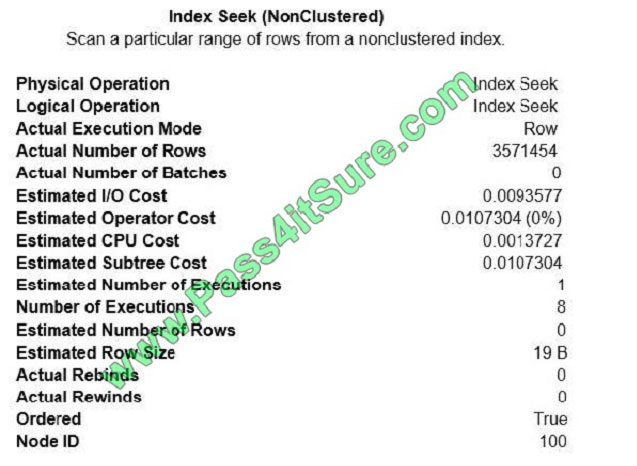
You need to resolve the performance issue. Solution: You drop the nonclustered index. Does the solution meet the
goal?
A. Yes
B. No
Correct Answer: B
We see Actual Number of Row is 3571454, while Estimated Number of Rows is 0. This indicates that the statistics are
old, and need to be updated.
QUESTION 7
You are designing a stored procedure for a database named obi.
The following requirements must be met during the entire execution of the stored procedure:
*The stored procedure must only read changes that are persisted to the database.
*select statements within the stored procedure should only show changes to the data that are made by the stored
procedure
You need to configure the transaction isolation level for the stored procedure.
Which Transact-SQL statement or statements should you run?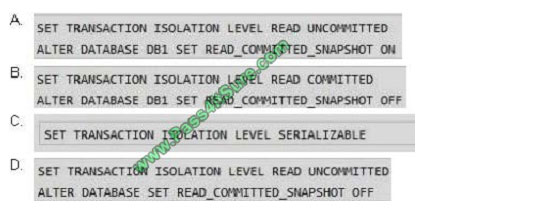
A. B. C. D.
Correct Answer: A
QUESTION 8
Note: This question is part of a series of questions that use the same scenario. For your convenience, the scenario is
repeated in each question. Each question presents a different goal and answer choices, but the text of the scenario is
exactly the same in each question in this series.
You have a database named DB1 that contains the following tables: Customer, CustomerToAccountBridge, and
CustomerDetails. The three tables are part of the Sales schema. The database also contains a schema named Website.
You create the Customer table by running the following Transact-SQL statement: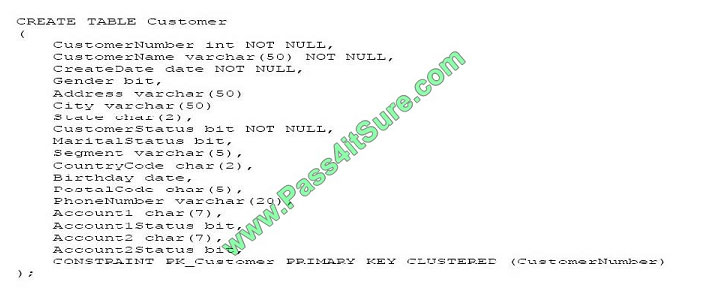
The value of the CustomerStatus column is equal to one for active customers. The value of the Account1Status and
Account2Status columns are equal to one for active accounts. The following table displays selected columns and rows
from the Customer table.

You plan to create a view named Website.Customer and a view named Sales.FemaleCustomers. Website.Customer
must meet the following requirements:
*
Allow users access to the CustomerName and CustomerNumber columns for active customers.
*
Allow changes to the columns that the view references. Modified data must be visible through the view.
*
Prevent the view from being published as part of Microsoft SQL Server replication.
Sales.Female.Customers must meet the following requirements:
*
Allow users access to the CustomerName, Address, City, State and PostalCode columns.
*
Prevent changes to the columns that the view references.
*
Only allow updates through the views that adhere to the view filter. You have the following stored procedures:
spDeleteCustAcctRelationship and spUpdateCustomerSummary. The spUpdateCustomerSummary stored procedure
was created by running the following Transacr-SQL statement:

You run the spUpdateCustomerSummary stored procedure to make changes to customer account summaries. Other
stored procedures call the spDeleteCustAcctRelationship to delete records from the CustomerToAccountBridge table.
You must update the design of the Customer table to meet the following requirements.
*
You must be able to store up to 50 accounts for each customer.
*
Users must be able to retrieve customer information by supplying an account number.
*
Users must be able to retrieve an account number by supplying customer information.
You need to implement the design changes while minimizing data redundancy.
What should you do?
A.
Split the table into three separate tables. Include the AccountNumber and CustomerID columns in the first table. Include
the CustomerName and Gender columns in the second table. Include the AccountStatus column in the third table.
B.
Split the table into two separate tables. Include AccountNumber, CustomerID, CustomerName and Gender columns in
the first table. Include the AccountNumber and AccountStatus columns in the second table.
C.
Split the table into two separate tables, Include the CustomerID and AccountNumber columns in the first table. Include
the AccountNumber, AccountStatus, CustomerName and Gender columns in the second table.
D.
Split the table into two separate tables, Include the CustomerID, CustomerName and Gender columns in the first table.
IncludeAccountNumber, AccountStatus and CustomerID columns in the second table.
Correct Answer: D
Two tables are enough. CustomerID must be in both tables.
QUESTION 9
Note: This question is part of a series of questions that present the same scenario. Each question in the series contains
a unique solution. Determine whether the solution meets the stated goals. You have a table that has a clustered index
and a nonclustered index. The indexes use different columns from the table. You have a query named Query1 that uses
the nonclustered index. Users report that Query1 takes a long time to report results. You run Query1 and review the
following statistics for an index seek operation: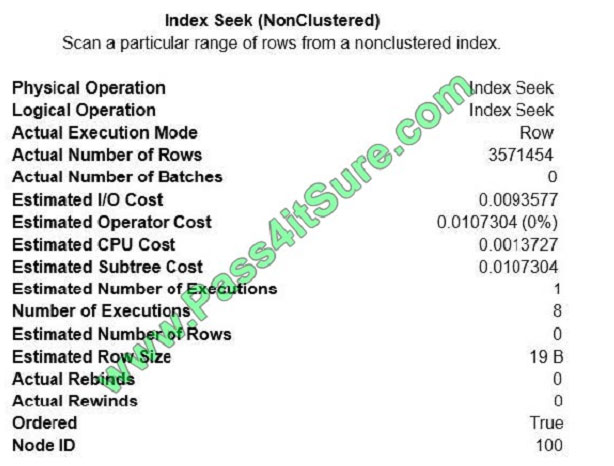
You need to resolve the performance issue.
Solution: You update statistics for the nonclustered index.
Does the solution meet the goal?
A. Yes
B. No
Correct Answer: A
We see Actual Number of Row is 3571454, while Estimated Number of Rows is 0. This indicates that the statistics are
old, and need to be updated.
QUESTION 10
You have multiple stored procedures inside a transaction.
You need to ensure that all the data modified by the transaction is rolled back if a stored procedure causes a deadlock
or times out.
What should you do?
A. Use the NOLOCK option.
B. Execute the DBCC UPDATEUSAGE statement.
C. Use the max worker threads Option.
D. Use a table-valued parameter.
E. Set SET ALLOW SNAPSHOT ISOLATION to ON,
F. Set SET XACT ABORT to ON.
G. Execute the alter table T1 set (lock escalation = auto); statement.
H. Use the output parameters.
Correct Answer: B
QUESTION 11
Note: This question is part of a series of questions that present the same scenario. Each question in the series contains
a unique solution. Determine whether the solution meets the stated goals.
You have a database that contains a table named Employees. The table stores information about the employees of your
company.
You need to implement and enforce the following business rules:
-Limit the values that are accepted by the Salary column.
-Prevent salaries less than $15,000 and greater than $300,000 from being entered.
-Determine valid values by using logical expressions.
–
Do not validate data integrity when running DELETE statements.
Solution: You implement cascading referential integrity constraints on the table.
Does the solution meet the goal?
A.
Yes
B.
No
Correct Answer: A
References: https://technet.microsoft.com/en-us/library/ms186973(v=sql.105).aspx
QUESTION 12
Note: This question is part of a series of questions that present the same scenario. Each question in the series contains
a unique solution that might meet the stated goals. Some questions sets might have more than one correct solution,
while others might not have a correct solution.
After you answer a question in this section, you will NOT be able to return to it. As a result, these questions will not
appear in the review screen.
You have a database that is 130 GB and contains 500 million rows of data.
Granular transactions and mass batch data imports change the database frequently throughout the day. Microsoft SQL
Server Reporting Services (SSRS) uses the database to generate various reports by using several filters.
You discover that some reports time out before they complete.
You need to reduce the likelihood that the reports will time out.
Solution: You create a file group for the indexes and a file group for the data files. You store the files for each file group
on separate disks.
Does this meet the goal?
A. Yes
B. No
Correct Answer: A
Consider creating two additional File Groups: Tables and Indexes. It is best not to put your stuff in PRIMARY as that is
where SQL SERVER stores all of its data and meta-data about your objects. You create your Table and Clustered Index
(as that is the data for the table) on [Tables] and all Non-Clustered indexes on [Indexes].
QUESTION 13
Note: This question is part of a series of questions that present the same scenario. Each question in the series contains
a unique solution. Determine whether the solution meets the stated goals. The Account table was created by using the
following Transact-SQL statement:
There are more than 1 billion records in the Account table. The AccountNuwber column uniquely identifies each
account. The productcode column has 100 different values. The values are evenly distributed in the table. Table
statistics are
refreshed and up to date.
You frequently run the following Transact-SQL select statements:
SELECT ProductCode, SUM(Balance) AS TotalSUH FROM Account WHERE ProductCode \\’CD\\’ GROUP 8Y
ProductCode; SELECT AccountNupber, Balance FROM Account WHERE ProductCode – \\’CD”;
You must avoid table scans when you run the queries.
You need to create one or more indexes for the table. Solution: You run the following Transact-SQL statements:

Does the solution meet the goal?
A. Yes
B. No
Correct Answer: A
Follow Pass4itsure free sharing of YouTube channels
We offer more ways to make it easier for everyone to learn, and YouTube is the best tool in the video. Follow channels: https://www.youtube.com/channel/UCTP5RClZrtMxtRkSvIag0DQ/videos get more useful exam content.
Share Pass4itsure coupons for free

Reasons to choose Pass4itsure
Pass4itsure offers the latest exam practice questions and answers free of charge! Update all exam questions throughout the year,
with a number of professional exam experts! To make sure it works! Maximum pass rate, best value for money! Helps you pass the exam easily on your first attempt.

This maybe you’re interested
Summarize:
Collecting the latest and most effective Microsoft MCSA 70-762 exam practice questions to help you improve exam success,
70-762 pdf and 70-762 video learning make it easier to gain knowledge! Full 70-762 exam dump: Experts recommend real leader Pass4itsure. Click here to easily pass the 70-762